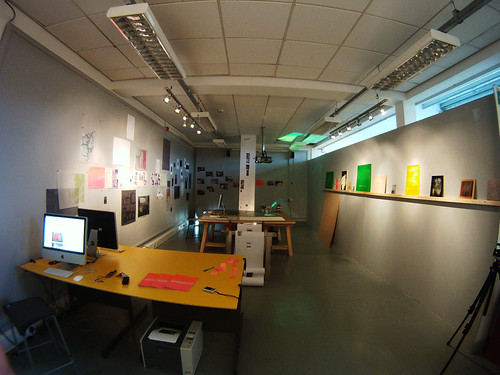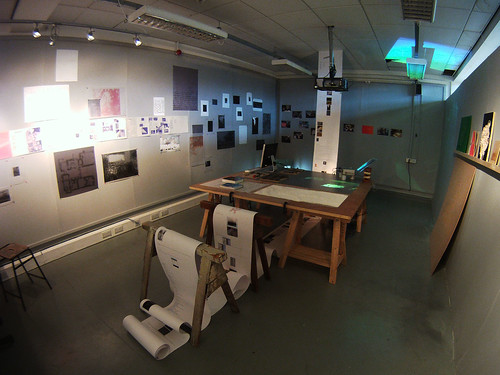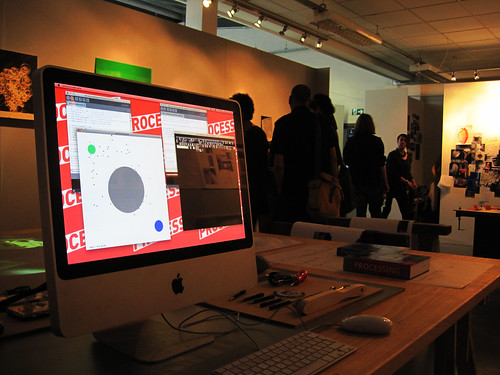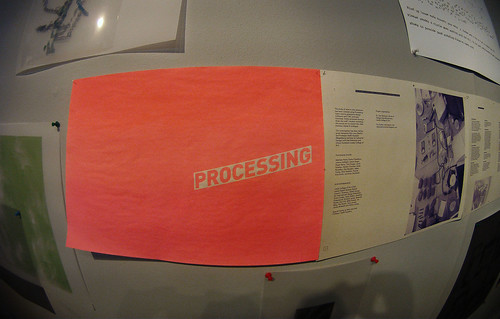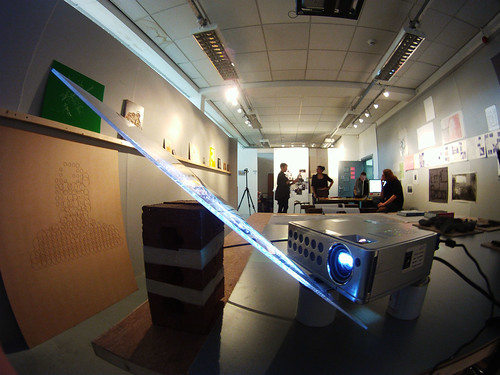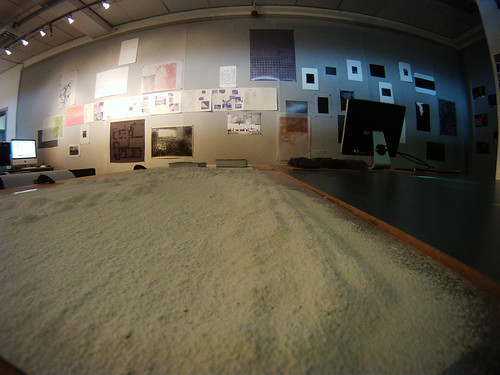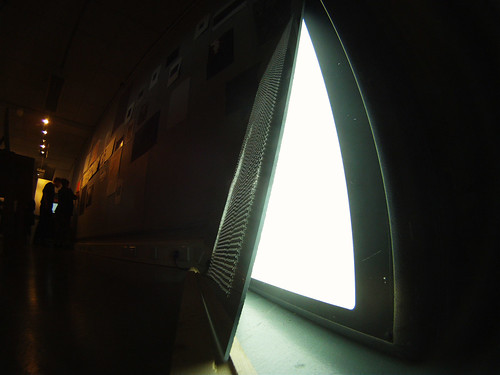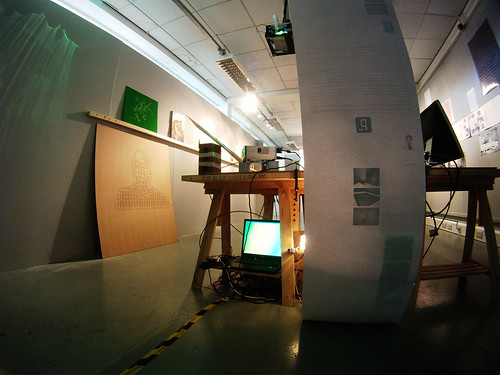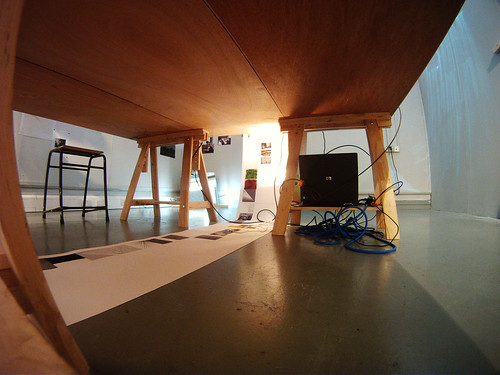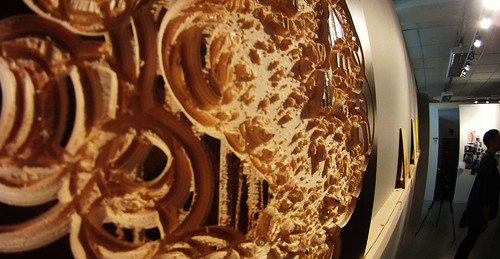11.20.2011
11.17.2011
Processing Design Fabrication
Reflections on the Processing Workshop
“…Processing is an open source programming environment for people who want to create images, animations, and interactions. With the coding based system processing converts the data in generated information. Data in many formats can be imported, manipulated, and exported.
The potential of the software environment of Processing combined with the CNC or photo-etched process of "tooling" (milling, drilling, shaping and sketching) opens new challenges for designers. The Processing based sketches becomes "tactile" with material properties.
Thank you for the invitation – Steffi Hußlein”
Thoughts on Interaction Design
Interaction Design is a process of designing with digital materials, physical negotiations and human communication. Basically, the challenge of human-system interface is to create user-friendly, effective, easy to use interactive systems for today and your future.
The appropriate combination of software and hardware is the key to the design process: the design of forms and functions (Product Design) linked with the integrated design of networked information and often most complex story-driven interactive formats (Interaction Design).
“…Processing is an open source programming environment for people who want to create images, animations, and interactions. With the coding based system processing converts the data in generated information. Data in many formats can be imported, manipulated, and exported.
The potential of the software environment of Processing combined with the CNC or photo-etched process of "tooling" (milling, drilling, shaping and sketching) opens new challenges for designers. The Processing based sketches becomes "tactile" with material properties.
Thank you for the invitation – Steffi Hußlein”
Thoughts on Interaction Design
Interaction Design is a process of designing with digital materials, physical negotiations and human communication. Basically, the challenge of human-system interface is to create user-friendly, effective, easy to use interactive systems for today and your future.
The appropriate combination of software and hardware is the key to the design process: the design of forms and functions (Product Design) linked with the integrated design of networked information and often most complex story-driven interactive formats (Interaction Design).
Geetings and thoughts from Rob!
Why should artists use CNC machinery, code and programming?
The coding for the input side is new, almost none of the participants have experience in developing complex scripts to feed the computer. So in programming terms the results are very basic and the quality of expression is constrained to the basics. The challenge is to develop an artistic standpoint. The use of CNC machinery for output was limited in the same way like the input, as it is complicated to direct a CNC router to make moves. Manual control of a tool is much more direct. So for everybody it felt like drawing a picture without using their hands, guiding the brush only with the lips. After getting over this frustration the workshop showed what could be achieved even with this limited abilities. Provided with the same processing sketch the participants saw the diverseness of output that can be created. Everybody using the same sketch, creating different images, a whole image space was evolved. With this understanding the motivation rose to create individual and collaborative expressions within this constrained environment.
The workshop demonstrated the complexity of new tools for design and art. In the past this process would have involved a computer scientist, an artist, a machinist and a coordinator. After three days of discussion the workflow was understood and began to output. For some it was not easy to be confronted with tasks never done before. Flexibility and team spirit succeeded and made this workshop a great starting point for further development.
Thank You for the invitation. Robert Laux
The coding for the input side is new, almost none of the participants have experience in developing complex scripts to feed the computer. So in programming terms the results are very basic and the quality of expression is constrained to the basics. The challenge is to develop an artistic standpoint. The use of CNC machinery for output was limited in the same way like the input, as it is complicated to direct a CNC router to make moves. Manual control of a tool is much more direct. So for everybody it felt like drawing a picture without using their hands, guiding the brush only with the lips. After getting over this frustration the workshop showed what could be achieved even with this limited abilities. Provided with the same processing sketch the participants saw the diverseness of output that can be created. Everybody using the same sketch, creating different images, a whole image space was evolved. With this understanding the motivation rose to create individual and collaborative expressions within this constrained environment.
The workshop demonstrated the complexity of new tools for design and art. In the past this process would have involved a computer scientist, an artist, a machinist and a coordinator. After three days of discussion the workflow was understood and began to output. For some it was not easy to be confronted with tasks never done before. Flexibility and team spirit succeeded and made this workshop a great starting point for further development.
Thank You for the invitation. Robert Laux
11.16.2011
int workshopDays = 3
So here we are, on the other side. Anyway below is a selection of my images produced through Processing code.
-Adam
INTRODUCTORY QUOTES
CHERYL HUNTBACH - "In my practice, I use meticulous and repetitive processes. Working within prescribed perimeters in order to explore and push the nuances of drawing."
ROGER BERRY - "I have previously experimented with CNC machinery that has allowed me to explore the random use of paintbrush strokes on a static surface. Random use of colours also created rather interesting results, but the use of indian inks doesn't work because all colours ultimately turn brown in a short period of time."
MATT PARKES - "I like to think of this technology as a way of making people that are artistically inclined able to have full control over the output of their work."
JAMES SMART - "I come from a fine art background, and have experimented with the exploration of materials and investigating the process of making. This has now extended into software/computers and related technology."
TOM - KNAPP "I have primarily used computers as a way of creating music and to set up a system that I can interact with, the majority of what I do is live performance and I have also used audio to drive real-time computer graphic systems."
ZOE MOYDEN - "My work is largely based around the experience of reading and interacting with books, this ranges from the process of making books in an extremely labour intensive manner to the act of submerging yourself into the literature itself. I ultimately explore literature as a means of art."
ELISA HEIKKILA - "My work explores the notions of female identity and the way that this can change throughout life experiences, such as motherhood."
ADAM CLULEY - "My body of work explores the notions of space and environment and the investigation of utopias and dystopias, with my current project I aim to draw comparisons between solitary and social microcosms. "
DAN ROBINSON - "I work with events and images of events, often drawings. I like to use different time-scales, so for example a drawing proposes an event, an event happens and then further images document it. I'm really interested in this clash of digital and analogue.
In my teaching practice I work with collaboration and bringing together different disciplines. For this workshop, I believe it's really important that teaching staff, technical staff and students are all working together, outside the confines of their normal roles."
CAROL SOWDEN - "My work explores the natural world and the physicality of the land and it's material. The processes that I use and the rawness of such materials is extremely important to me."
KATIE BROADLEY - "My current practice explores rules, boundaries and obstruction. It is these themes that I want to apply to Processing by generating digital instruction that stretches the boundaries of the process.
VARSHA CHOUHAN - "I explore the concept of globalisation of beauty and the ideals created, this is largely from a female perspective, i also explore identity and gender sexuality with regards to varying cultures. At the moment I'm looking at the relationship between human emotions and hair. I have touched upon hair being a symbol of beauty and I am interested in how this can quickly become the abject."
GINA STOCKWELL - "I am largely concerned with mental health issues and the way that the human brain and emotions work, I like to explore the relationship between fantasy and reality. Through digital media I explore manipulation of images, mirroring how the mind can manipulate the perception of reality when faced with such chemical imbalance."
PATRICK KIRK-SMITH- "Processing is not a method that I use in my practice generally, but I am interested in manipulating code using automated software to generate text."
JOANNA GELDARD - "I've landed from a greenhouse, I explore the edge of spaces, so I work with diagrams, maps and blueprints to reinterpret voids, this means I have used a variety of processes from technical through to performance."
PAULA CHAMBERS - "I am a 3D artist who subverts objects, I am exploring what it means to inhabit a female body in the 21st Century, i use contextually relevant materials and processes, this creates strong narrative themes and imagery."
ROGER BERRY - "I have previously experimented with CNC machinery that has allowed me to explore the random use of paintbrush strokes on a static surface. Random use of colours also created rather interesting results, but the use of indian inks doesn't work because all colours ultimately turn brown in a short period of time."
MATT PARKES - "I like to think of this technology as a way of making people that are artistically inclined able to have full control over the output of their work."
JAMES SMART - "I come from a fine art background, and have experimented with the exploration of materials and investigating the process of making. This has now extended into software/computers and related technology."
TOM - KNAPP "I have primarily used computers as a way of creating music and to set up a system that I can interact with, the majority of what I do is live performance and I have also used audio to drive real-time computer graphic systems."
ZOE MOYDEN - "My work is largely based around the experience of reading and interacting with books, this ranges from the process of making books in an extremely labour intensive manner to the act of submerging yourself into the literature itself. I ultimately explore literature as a means of art."
ELISA HEIKKILA - "My work explores the notions of female identity and the way that this can change throughout life experiences, such as motherhood."
ADAM CLULEY - "My body of work explores the notions of space and environment and the investigation of utopias and dystopias, with my current project I aim to draw comparisons between solitary and social microcosms. "
DAN ROBINSON - "I work with events and images of events, often drawings. I like to use different time-scales, so for example a drawing proposes an event, an event happens and then further images document it. I'm really interested in this clash of digital and analogue.
In my teaching practice I work with collaboration and bringing together different disciplines. For this workshop, I believe it's really important that teaching staff, technical staff and students are all working together, outside the confines of their normal roles."
CAROL SOWDEN - "My work explores the natural world and the physicality of the land and it's material. The processes that I use and the rawness of such materials is extremely important to me."
KATIE BROADLEY - "My current practice explores rules, boundaries and obstruction. It is these themes that I want to apply to Processing by generating digital instruction that stretches the boundaries of the process.
VARSHA CHOUHAN - "I explore the concept of globalisation of beauty and the ideals created, this is largely from a female perspective, i also explore identity and gender sexuality with regards to varying cultures. At the moment I'm looking at the relationship between human emotions and hair. I have touched upon hair being a symbol of beauty and I am interested in how this can quickly become the abject."
GINA STOCKWELL - "I am largely concerned with mental health issues and the way that the human brain and emotions work, I like to explore the relationship between fantasy and reality. Through digital media I explore manipulation of images, mirroring how the mind can manipulate the perception of reality when faced with such chemical imbalance."
PATRICK KIRK-SMITH- "Processing is not a method that I use in my practice generally, but I am interested in manipulating code using automated software to generate text."
JOANNA GELDARD - "I've landed from a greenhouse, I explore the edge of spaces, so I work with diagrams, maps and blueprints to reinterpret voids, this means I have used a variety of processes from technical through to performance."
PAULA CHAMBERS - "I am a 3D artist who subverts objects, I am exploring what it means to inhabit a female body in the 21st Century, i use contextually relevant materials and processes, this creates strong narrative themes and imagery."
Week in Processing.
For a workshop dominated by us Interdiscplinarists (a species heavily practised in raw process) being thrown into a three-day intensive-course in computer programming, was a bit of a shock to the system. Even so, everyones', modified, ideas have been realised; made use of the online open-source processing society (the biggest blessing of the week); and, largely, created a pretty lively discussion/atmosphere.
I came into the workshop with, what I tought was, a reasonable amount of experience (and the understanding that processing was a little bit like Barry Manilow) but I've learned more in these three days than I probably ever have in all my high school I.C.T lessons put together. I'll almost certainly be using this software again. Just a quick look at what we've produced (interdisciplinarists, technical staff, et al) in three days, shows the almost infinite possibilities of this software.
Once we came to terms with square eyes and tempermantal air conditioning, it was a massively enjoyable few days.

I came into the workshop with, what I tought was, a reasonable amount of experience (and the understanding that processing was a little bit like Barry Manilow) but I've learned more in these three days than I probably ever have in all my high school I.C.T lessons put together. I'll almost certainly be using this software again. Just a quick look at what we've produced (interdisciplinarists, technical staff, et al) in three days, shows the almost infinite possibilities of this software.
Once we came to terms with square eyes and tempermantal air conditioning, it was a massively enjoyable few days.

=
day 3.
Experiments with drawing, shape, colour, transparency and random values.






Today we formed collaborative groups. The group I worked with (Cheryl Huntbach, Varsha Chouhan, Elisa Heikkila and myself) used processing to drive the CNC and the laser cutter to make work exploring abstraction and repetition on various surfaces.
Labels:
abstraction,
alpha,
CNC,
colour,
laser cutter,
random,
transparency
Subscribe to:
Posts (Atom)

